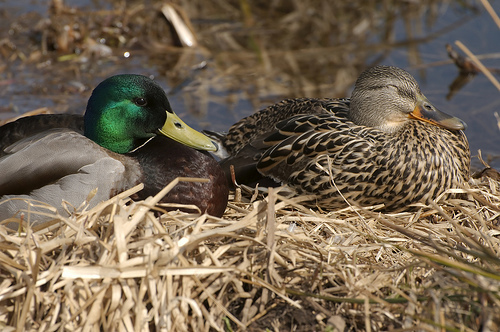| << Chapter < Page | Chapter >> Page > |
Author: Allen Gu

Mallards, like most waterfowl, form seasonally monogamous pair-bonds during the fall or winter before breeding season. During this time, the male stays close to the female to guard her from predators and other males until she lays her eggs which allows her to spend more time feeding to cope with the increased energy requirements for producing her clutch (Losito 1996). When the breeding season arrives, the males’ plumages changes noticeably so that drakes take on their distinctive green hood and begin to court the females, known as hens , see [link] . This ritual begins with head pumping and specific calls from the drake to which the hen responds and ends with the drake mounting her, grasping her neck feathers, and thrusting (McKinney 1983). Mating ends within a minute after which the two begin post-copulatory rituals (McKinney 1983). After the hens begin laying their clutch, the drakes, leave them and begin to attempt forced copulations with other females that are still fertile (Davis 2002). It can usually be assumed that males will not form new pair bonds because all other females have already bonded, (Goodburn 1984).
The mallard is roughly 0.6m or 2 ft long and has a wingspan of 82-95 cm or 32-37 in. Its breeding season begins in late March or early April. The female builds the nest by herself, usually in a concealed area near the water, and has an average clutches have 9 eggs. The eggs are laid one a day and incubated for 22-28 days. Down feathers from the female are shed to insulate heat. If a nest is destroyed the female can rebuild but is unlikely to lay as many eggs (Goode).
Mallards are primarily vegetarians that eat things like leaves, wheat, rice, and willows, but they will also feed on small fish, tadpoles, and snails. Mallards migrate in the winter to warmer areas in the central and southern United States (Goode).

Notification Switch
Would you like to follow the 'Mockingbird tales: readings in animal behavior' conversation and receive update notifications?